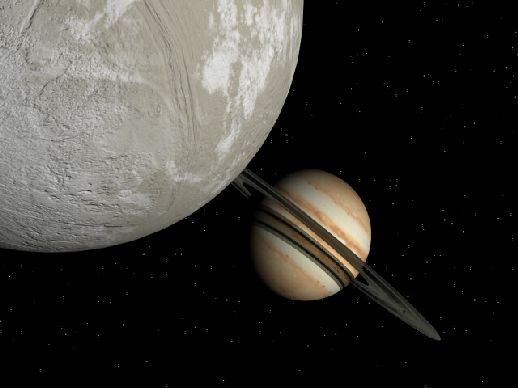Credit & Copyright: John Whatmough,
Extrasolar Visions
Explanation:
In the last few years, observational astronomy has given humanity
evidence of the existence of worlds beyond the
solar system.
Solar-type stars are now inferred to
harbor planets of approximately
Jupiter mass - some residing in temperature zones
which could conceivably
support liquid water and
therefore life!
Above is a hypothetical scene near one such planet
whose sun, 47 Ursae Majoris (47 UMa), is very similar to our own.
In our sky, 47 UMa
appears as a faint, inconspicuous
star below the cup of the
"the Big Dipper".
(Our own sun would be equally inconspicuous
when viewed from 47 UMa ...)
Astronomers G. Marcy and P. Butler announced the
discovery of a planet associated with this star
in 1996 and reported it to have a mass of
about 2.4 Jupiters or more with an orbital period of 3 years.
This artist's extrasolar vision pictures the detected planet,
47 UMa b, as a gas giant surrounded by a ring of
material - analogous to our own
gas giant Saturn.
In the foreground lies a hypothetical moon of 47 UMa b.
Could such a moon support life?
47 UMa is only 44 light years distant, fairly
close by astronomical standards - yet there is evidence for
planetary systems which are closer still.
NASA plans to explore nearby planetary systems using spaceborne
observatories.
1999 2000 2001 2002 2003 2004 2005 2006 2007 2008 2009 2010 2011 2012 2013 2014 2015 2016 2017 2018 2019 2020 2021 2022 2023 2024 2025 |
Январь Февраль Март Апрель Май Июнь Июль Август Сентябрь Октябрь Ноябрь Декабрь |
NASA Web Site Statements, Warnings, and Disclaimers
NASA Official: Jay Norris. Specific rights apply.
A service of: LHEA at NASA / GSFC
& Michigan Tech. U.
|
Публикации с ключевыми словами:
life - Sun - planet - жизнь во Вселенной - Планета-гигант
Публикации со словами: life - Sun - planet - жизнь во Вселенной - Планета-гигант | |
См. также:
Все публикации на ту же тему >> | |
